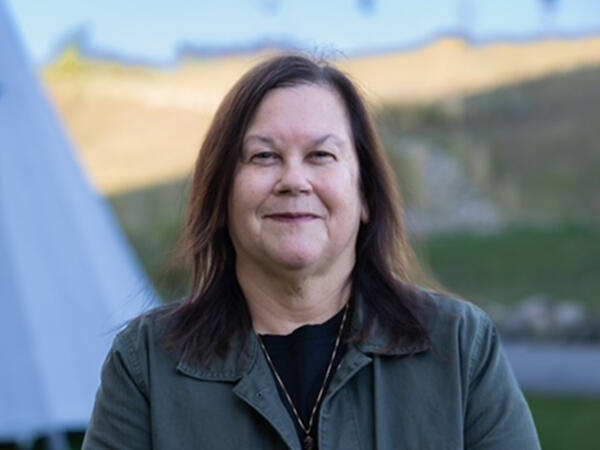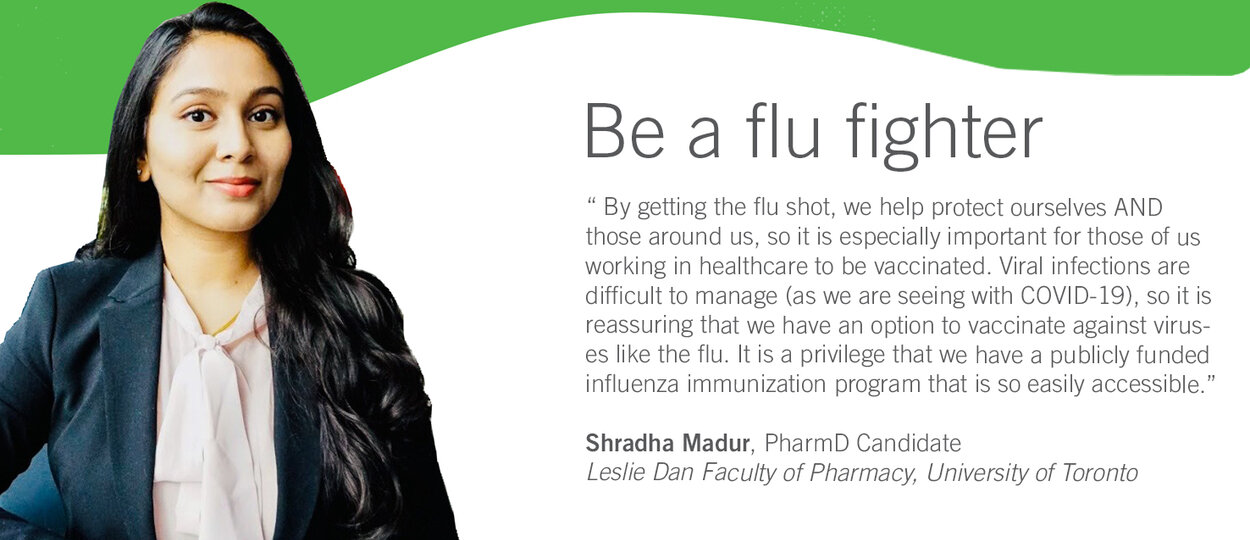PharmD student Shradha Madur shares her experience at Holland Bloorview Kids Rehabilitation Hospital
Fourth-year PharmD student Shradha Madur completed her block six Advanced Pharmacy Practice Experience (APPE) rotation at the end of November at Holland Bloorview Kids Rehabilitation Hospital.
Madur was supervised by her preceptor Carly Diamond, who is a paediatric pharmacist and she was also co-precepted by fellow paediatric pharmacist Tamara Milicevic who is an alumna of the PharmD for Pharmacists program. Not only did Madur provide direct patient care to a dynamic pediatric population, she did so while leading the hospital’s inpatient flu vaccine campaign during a global pandemic.
LDFP Communications spoke with Madur about her unique experience providing pediatric pharmacy care, how she overcame challenges, and lessons learned related to COVID-19.
Tell us about your experience working at Holland Bloorview Kids Rehabilitation Hospital.
Since this is a rehabilitation hospital, most patients stay here for several weeks and receive continuous follow-up from health-care professionals that monitor their progress. Pharmacists have detailed educational sessions with caregivers and play an active role in managing patients’ medication during their stay.
Various health-care professionals work together as part of a large interdisciplinary team to help patients transition to Holland Bloorview from their previous institution and then help them transition back into their homes. It was an enriching experience to see how collaboratively an interprofessional team functions. There were profession-specific care plans for each patient, as well as interprofessional care plans to keep track of the therapy provided by various specialties.
What was it like working in a hospital during a pandemic? Can you share any lessons learned?
Daily screenings were conducted before anyone was allowed to enter the hospital along with provision of medical grade masks based on the type of patient care provided. There were also general restrictions on the number of visitors allowed inside. Personal spaces and equipment had to be sanitized multiple times throughout the day. Individuals had to be mindful while using shared spaces, making sure hospital policies were followed at all times.
In terms of patient care, extra precautions had to be taken and we donned additional PPE when visiting units. Since it was a pediatric setting, not all patients could wear masks so caregiver and health-care provider precautions were critical to ensure safety of patients.
It was difficult to allow patients and their caregivers go home for the weekend, because when they come back for re-admission, they had to be reassessed for exposure, since it could be putting other patients, caregivers and staff at risk.
Meetings, educational sessions, events etc. were moved to online platforms due to limitations on the number of people allowed for in-person meetings and social distancing measures. A lot of care was taken to ensure activities were aligned with rules and regulations.
It was a great experience working in a hospital during a pandemic. The flu campaign had higher rates of acceptance than last year. In addition, several adjustments had to be made to the daily schedule in the pharmacy due to restrictions. There were regular updates to on these restrictions so everyone had to keep track of these changes.
Overall, I can appreciate that it takes a lot of consistent planning and teamwork to develop, implement and revise safety regulations in a hospital.
How is pharmacy practice different in a pediatric setting?
Pediatric care is dynamic. Kids’ growth parameters and developmental milestones must be considered while providing pharmacotherapy. Dosing is tailored to their weight, and regularly reassessed. It is important to ensure the most effective and safe medication is used because pediatric patients have low tolerance to pain, greater risk of side-effects and also tend to experience irritability and frustration easily.
During the five-week direct patient care component, I learned how to take medication histories, develop care plans and tailor patient education sessions to a pediatric setting. Providing pharmaceutical care in a pediatric rehabilitation setting is different from an adult inpatient setting because of the lack of well-developed guidelines for management of complex conditions in pediatrics.
A lot of factors must be considered when assessing appropriateness of therapy when working with children. As a result, there was a lot of on-site learning to supplement my knowledge from in-class sessions last year.
Is there anything that surprised you about your hospital experience?
What stood out for me was the amount of background work that pharmacists do to implement campaigns and projects. In addition to managing daily clinical duties, pharmacists have additional responsibilities, such as creating health promotion campaigns (i.e. flu vaccine campaign), educational materials, presenting to committees and performing various assessments or analyses of patient care.
What surprised me were the number medications that are used off-label in managing complex conditions in pediatrics. I would not expect to see certain medications being used in children, but in complex cases in which the patient is in a hospital setting with continuous monitoring, many medications can actually be used off-label.
There is a lot of extrapolation in paediatrics due to lack of research and this is the most challenging part of working with the paediatric population. I was also surprised at the number of complex conditions that can occur in paediatrics and the limited number of pharmacotherapy guidelines that are out there for these conditions.
What was the most rewarding part?
The most rewarding aspect is seeing a patient’s condition improve over time. It is also very heart-warming to see their parents’ or caregivers’ happiness as their child shows signs of recovery and improvement.
I had the opportunity to present to various hospital committees promoting the flu campaign. It was great to see my work requested by fellow health care professionals, and it was fascinating to see that some of the information I presented was being used to help make revisions to policies.
Describe any challenges you've faced and how you overcame them.
Dosage forms are crucial in pediatric setting. It’s important to consider a patient’s ability to intake or swallow various textures and tailor their medications appropriately. Some patients had a naso-gastric tube that required medications to be crushed, dissolved or compounded into a suspension.
To overcome these issues, I collaborated with pharmacy technicians, parents, caregivers, nurses and physicians to find an appropriate options for each patient. I also consulted with multiple resources to confirm compatibility and stability of medications as required.
It was often difficult to find dosing information for certain medications, due to a lack of studies and also because medications can have multiple uses in the pediatric population. I consulted various resources for specific dosing and at times had to extrapolate from non-pediatric population or related disorders.
Monitoring parameters in my care plans had to be tailored to paediatrics population, because certain side effects occur more frequently in children.
Has this experience inspired your future career aspirations?
Absolutely. Working in a pediatric rehabilitation setting was a new experience for me and I developed an interest in this area. This placement helped me develop a better understanding of the challenges faced by the pediatric population and the dynamic role of pharmacists in this institution.
More News
Image

Pharmacy alum sees change in acceptance of Indigenous cultures in health care
During Deborah Emery’s 40-year pharmacy career, she provided care in Sioux Lookout, Thunder Bay and Manitoulin Island.
Read More
Image

Grad to Watch: Jackie Fule Liu’s research focuses on better outcomes for diabetes patients
A recent PhD graduate, Jackie Fule Liu combines hands-on skill and big-picture thinking to help tackle diabetes care challenges.
Read More
Image

U of T community members recognized with Order of Canada
Congratulations to Dean Emeritus and Professor K. Wayne Hindmarsh on his appointment.
Read More
